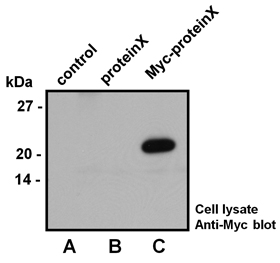navigation: home > Antikörper > Anti-c-Myc-tag
Anti-Myc-tag
Description
The Myc-tag is derived from a peptide within the human c-Myc proto-oncoprotein. The sequence of the ten amino acids comprising the Myc-tag (EQKLISEEDL) can be added to the amino- or carboxy-terminus of any protein by recombinant technology. Importantly, the monoclonal antibody directed against the Myc-tag shows low background binding to other proteins even in high complexity samples such as whole cell lysates. The Myc-tag is one of the most widely used epitope tags in research labs around the world and our purified monoclonal antibody can be used in Western Blotting, immunoprecipitation, or immunostaining of cells and tissues. As the Myc-tag coding sequence is an integral part of many commercial expression vectors, this antibody is a must in every laboratory.
Product
Immunogen:
Synthetic peptide (EQKLISEEDL) derived
from the human c-Myc protein.
Antibody-type:
mouse monoclonal (clone TT5)
Isotype:
IgG1
Concentration:
0,5 mg/ml
Purification:
Protein G affinity chromatography
Supplied buffer:
PBS, pH 7.2, containing 50% glycerol.
Shipping and storage
Shipping:
Antibody is shipped in cold case
Storage:
Antibody is stable for 1 month at 4°C. For prolonged storage, the antibody should be stored at -20°C. Aliquot to avoid repeated freeze-thaw-cycles. At -20°C, the product is stable for at least 1 year from shipment.
Use
For research use only. Not for diagnostic or therapeutic purpose.
Applications

Western Blotting with the myc-tag antibody
Lysates from human HEK293 cells transiently
transfected with the empty vector (control; lane A)
or a eukaryotic expression vector encoding
a ~20 kDa protein either without (proteinX; lane B)
or with an amino-terminal Myc-tag (myc-proteinX;
lane C) were separated by SDS-PAGE and
transfered onto a PVDF membrane.
The membrane was probed with the anti-Myc-tag
antibody (clone TT5; 1:2,000 dilution).
Bound antibody was visualized using horseradish
peroxidase-coupled Protein G (1:10,000 dilution)
and chemiluminescence detection.
Exposure time 30 seconds. Equal amounts of
total protein were loaded in each lane.
Western Blotting: 1:500 – 1:2,000
Immunoprecipitation: 2 µg/sample
Immunofluorescence staining: 1:200
(paraformaldehyde-fixed cells and tissues)
Immunohistochemistry: 1:100
(cryosections)
Optimal dilutions are dependent on conditions and should be determined by the user.
![]()

